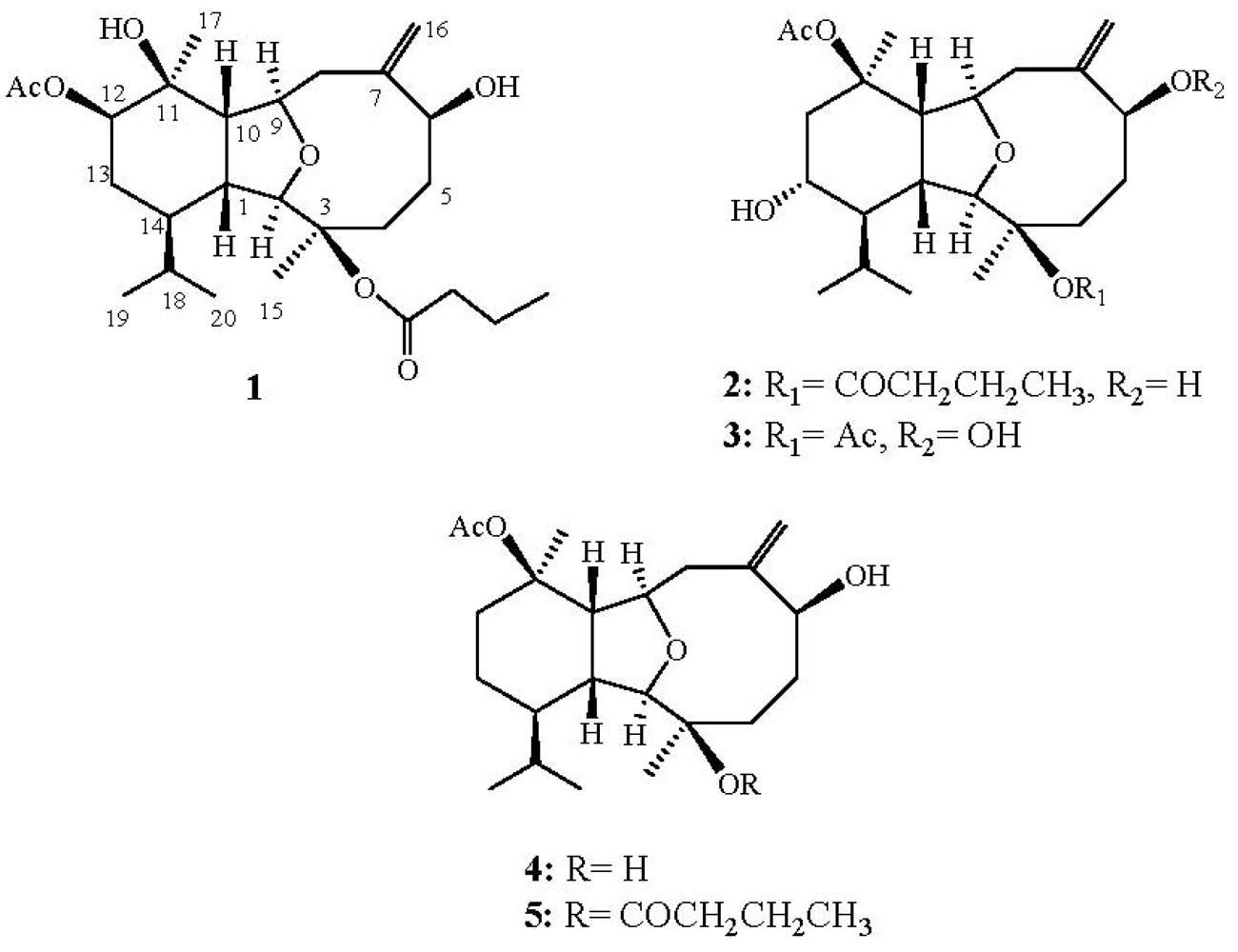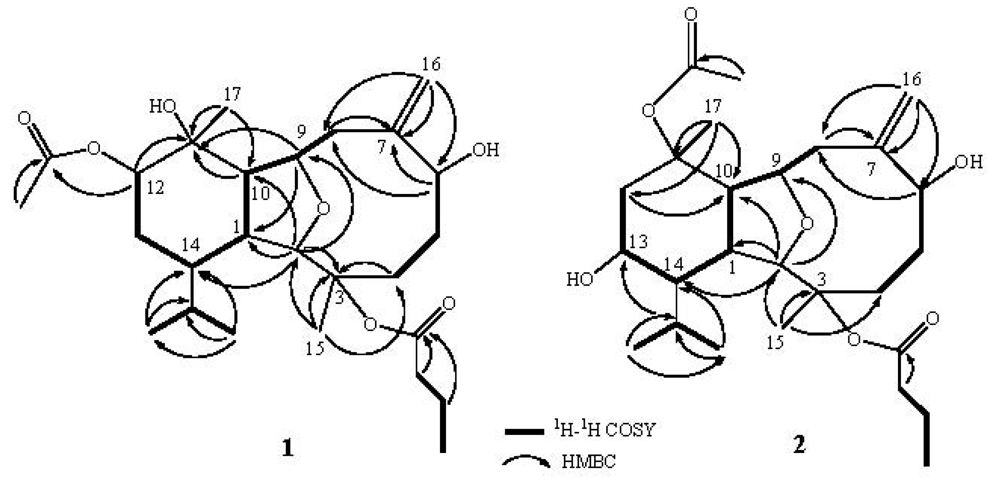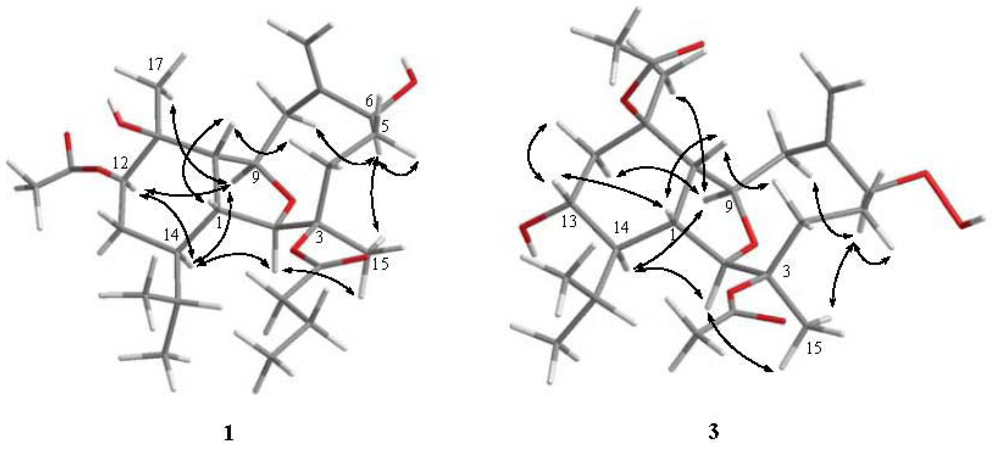Simplexins P–S, Eunicellin-Based Diterpenes from the Soft Coral Klyxum simplex
Abstract
:1. Introduction

2. Results and Discussion
| Position | 1 | 2 | 3 | 4 |
|---|---|---|---|---|
| 1 | 41.7 (CH) b | 43.0 (CH) | 43.1 (CH) | 41.5 (CH) |
| 2 | 89.8 (CH) | 91.6 (CH) | 91.4 (CH) | 91.4 (CH) |
| 3 | 84.4 (C) | 84.5 (C) | 84.6 (C) | 74.1 (C) |
| 4 | 28.7 (CH2) | 29.4 (CH2) | 30.0 (CH2) | 35.2 (CH2) |
| 5 | 35.3 (CH2) | 35.4 (CH2) | 30.0 (CH2) | 35.0 (CH2) |
| 6 | 73.0 (CH) | 73.5 (CH) | 87.3 (CH) | 74.1 (CH) |
| 7 | 150.3 (C) | 150.3 (C) | 145.6 (C) | 152.0 (C) |
| 8 | 41.0 (CH2) | 41.2 (CH2) | 41.9 (CH2) | 41.5 (CH2) |
| 9 | 78.4 (CH) | 79.2 (CH) | 78.9 (CH) | 78.2 (CH) |
| 10 | 50.2 (CH) | 45.5 (CH) | 45.0 (CH) | 46.4 (CH) |
| 11 | 71.1 (C) | 83.5 (C) | 83.3 (C) | 82.1 (C) |
| 12 | 75.5 (CH) | 42.2 (CH2) | 42.7 (CH2) | 32.4 (CH2) |
| 13 | 24.2 (CH2) | 66.8 (CH) | 66.8 (CH) | 18.1 (CH2) |
| 14 | 43.4 (CH) | 50.3 (CH) | 49.8 (CH) | 42.7 (CH) |
| 15 | 22.2 (CH3) | 22.7 (CH3) | 22.9 (CH3) | 27.6 (CH3) |
| 16 | 116.9 (CH2) | 117.0 (CH) | 118.2 (CH) | 117.2 (CH2) |
| 17 | 26.2 (CH3) | 25.2 (CH3) | 25.3 (CH3) | 25.4 (CH3) |
| 18 | 27.4 (CH) | 28.4 (CH) | 28.5 (CH) | 28.0 (CH) |
| 19 | 21.7 (CH3) | 24.8 (CH3) | 24.8 (CH3) | 21.8 (CH3) |
| 20 | 15.5 (CH3) | 15.8 (CH3) | 15.7 (CH3) | 15.0 (CH3) |
| 3-Ac | 22.3 (CH3) | |||
| 169.9 (C) | ||||
| 11-Ac | 22.4 (CH3) | 22.4 (CH3) | 22.6 (CH3) | |
| 170.0 (C) | 170.0 (C) | 170.3 (C) | ||
| 12-Ac | 21.2 (CH3) | |||
| 170.2 (C) | ||||
| 3- n-Butyrate | 13.6 (CH3) | 13.6 (CH3) | ||
| 18.4 (CH2) | 18.6 (CH2) | |||
| 37.3 (CH2) | 37.4 (CH2) | |||
| 172.6 (C) | 172.6 (C) |
| Position | 1 | 2 | 3 | 4 |
|---|---|---|---|---|
| 1 | 2.42 dd (12.0, 7.5) b | 2.24 dd (11.5, 7.0) | 2.20 dd (12.5, 7.0) | 2.27 dd (11.5, 7.5) |
| 2 | 3.58 s | 3.59 s | 3.58 s | 3.56 s |
| 4 | 2.20 m 1.80 m | 2.17 m 1.84 m | 2.10 m 1.97 m | 1.73 m |
| 5 | 2.12 m 1.71 m | 2.10 m 1.73 m | 2.13 m 1.54 m | 2.06 m 1.95 m |
| 6 | 4.33 dd (11.0, 4.0) | 4.30 br d (10.5) | 4.62 dd (10.5, 2.0) | 4.32 br d (10.5) |
| 8 | 2.84 dd (14.0, 4.5) | 2.83 dd (14.0, 5.0) | 2.83 dd (13.5, 5.0) | 2.86 dd (13.5, 5.5) |
| 2.47 d (14.0) | 2.47 d (14.0) | 2.55 d (13.5) | 2.51 d (13.5) | |
| 9 | 4.17 dd (11.0, 4.0) | 4.13 dd (10.5, 4.5) | 4.11dd (11.0, 5.0) | 4.09 dd (10.0, 5.5) |
| 10 | 2.66 dd (11.0, 7.5) | 3.08 dd (10.5,7.5) | 3.17 dd (10.5, 7.0) | 2.96 dd (10.0, 7.5) |
| 12 | 4.89 dd (11.7, 4.2) | 1.52 m | 1.54 m | 1.44 m |
| 2.41 m | 2.34 dd (13.5, 3.5) | 2.25 m | ||
| 13 | 1.61 m 1.70 m | 3.90 ddd (15.0, 13.2, 4.5) | 3.90 ddd (16.0, 11.0, 5.0) | 1.34 m |
| 1.46 m | ||||
| 14 | 1.41 m | 1.26 m | 1.26 t (11.0) | 1.19 m |
| 15 | 1.59 s | 1.56 s | 1.53 s | 1.16 s |
| 16 | 5.13 s 5.46 s | 5.22 s 5.47 s | 5.35 s 5.46 s | 5.30 s 5.61 s |
| 17 | 1.21 s | 1.57 s | 1.58 s | 1.54 s |
| 18 | 1.92 m | 1.92 m | 1.89 m | 1.79 m |
| 19 | 0.95 d (7.0) | 1.18 d (7.0) | 1.19 d (7.0) | 0.94 d (7.0) |
| 20 | 0.83 d (7.0) | 0.96 d (7.0) | 0.97 d (7.0) | 0.78 d (7.0) |
| 3-acetate | 1.95 s | |||
| 11-acetate | 2.00 s | 2.01 s | 2.01 s | |
| 12-acetate | 2.12 s | |||
| 3-n-butyrate | 0.92 t (7.5) | 0.94 t (7.5) | ||
| 1.60 m | 1.59 m | |||
| 2.13 m | 2.15 m | |||
| 6-OOH | 7.78 s |


| Cell Lines ED50 (µg/mL) | ||||
|---|---|---|---|---|
| Compound | K-562 | CCRF-CEM | T47D | MOLT 4 |
| 1 | >20 | 12.0 ± 1.6 | >20 | 30.3 ± 3.4 |
| 2 | >20 | >20 | >20 | >20 |
| 3 | 7.2 ± 2.4 | 2.7 ± 0.1 | 13.5 ± 2.8 | 3.8 ± 0.5 |
| 4 | >20 | 13.0 ± 0.9 | >20 | 16.4 ± 3.1 |
| 5 | >20 | 17.0 ± 2.9 | >20 | 18.2 ± 2.6 |
| 5-Fluorouracil | 2.3 ± 0.2 | 1.8 ± 0.3 | 9.8 ± 1.5 | 2.3 ± 0.3 |
3. Experimental Section
3.1. General Experimental Procedures
3.2. Animal Material
3.3. Extraction and Separation
3.4. Cytotoxicity Testing
Acknowledgments
References
- Wang, G.-H.; Sheu, J.-H.; Chiang, M.Y.; Lee, T.-J. Pachyclavulariaenones A–C, three novel diterpenoids from the soft coral Pachyclavularia violacea. Tetrahedron Lett. 2001, 42, 2333–2336. [Google Scholar]
- Wang, G.-H.; Sheu, J.-H.; Duh, C.-Y.; Chiang, M.Y. Pachyclavulariaenones D–G, new diterpenoids from the soft coral Pachyclavularia violacea. J. Nat. Prod. 2002, 65, 1475–1478. [Google Scholar] [CrossRef]
- Ahmed, A.F.; Wu, M.-H.; Wang, G.-H.; Wu, Y.-C.; Sheu, J.-H. Eunicellin-based diterpenoids, australins A–D, isolated from the soft coral Cladiella australis. J. Nat. Prod. 2005, 68, 1051–1055. [Google Scholar] [CrossRef]
- Su, J.-H.; Huang, H.-C.; Chao, C.-H.; Yan, L.-Y.; Wu, Y.-C.; Wu, C.-C.; Sheu, J.-H. Vigulariol, a new metabolite from the sea pen Vigularia juncea. Bull. Chem. Soc. Jpn. 2005, 78, 877–879. [Google Scholar] [CrossRef]
- Chen, B.-W.; Chang, S.-M.; Huang, C.-Y.; Chao, C.-H.; Su, J.-H.; Wen, Z.-H.; Hsu, C.-H.; Dai, C.-F.; Wu, Y.-C.; Sheu, J.-H. Hirsutalins A–H, eunicellin-based diterpenoids from the soft coral Cladiella hirsuta. J. Nat. Prod. 2010, 73, 1785–1791. [Google Scholar]
- Tai, C.-J.; Su, J.-H.; Huang, M.-S.; Wen, Z.-H.; Dai, C.-F.; Sheu, J.-H. Bioactive eunicellin-based diterpenoids from the soft coral Cladiella krempfi. Mar. Drugs 2011, 9, 2036–2045. [Google Scholar] [CrossRef]
- Hsu, F.-J.; Chen, B.-W.; Wen, Z.-H.; Huang, C.-Y.; Dai, C.-F.; Su, J.-H. Klymollins A–H, bioactive eunicellin-based diterpenoids from the Formosan soft coral Klyxum molle. J. Nat. Prod. 2011, 74, 2467–2471. [Google Scholar] [CrossRef]
- Chen, B.-W.; Wu, Y.-C.; Chiang, M.Y.; Su, J.-H.; Wang, W.-H.; Fan, T.-Y.; Sheu, J.-H. Eunicellin-based diterpenoids from the cultured soft coral Klyxum simplex. Tetrahedron 2009, 65, 7016–7022. [Google Scholar]
- Chen, B.-W.; Chao, C.-H.; Su, J.-H.; Wen, Z.-H.; Sung, P.-J.; Sheu, J.-H. Anti-inflammatory eunicellin-based diterpenoids from the cultured soft coral Klyxum simplex. Org. Biomol. Chem. 2010, 8, 2363–2366. [Google Scholar] [CrossRef]
- Chen, B.-W.; Chao, C.-H.; Su, J.-H.; Tsai, C.-W.; Wang, W.-H.; Wen, Z.-H.; Huang, C.-Y.; Sung, P.-J.; Wu, Y.-C.; Sheu, J.-H. Klysimplexins I–T, eunicellin-based diterpenoids from the cultured soft coral Klyxum simplex. Org. Biomol. Chem. 2011, 9, 834–844. [Google Scholar]
- Chen, B.-W.; Huang, C.-Y.; Wen, Z.-H.; Su, J.-H.; Wang, W.-H.; Sung, P.-J.; Wu, Y.-C.; Sheu, J.-H. Klysimplexins U–X, eunicellin-based diterpenoids from the cultured soft coral Klyxum simplex. Bull. Chem. Soc. Jpn. 2011, 84, 1237–1242. [Google Scholar] [CrossRef]
- Wu, S.-L.; Su, J.-H.; Wen, Z.-H.; Hsu, C.-H.; Chen, B.-W.; Dai, C.-F.; Kuo, Y.-H.; Sheu, J.-H. Simplexins A–I, eunicellin-based diterpenoids from the soft coral Klyxum simplex. J. Nat. Prod. 2009, 72, 994–1000. [Google Scholar] [CrossRef]
- Wu, S.-L.; Su, J.-H.; Lu, Y.; Chen, B.-W.; Huang, C.-Y.; Wen, Z.-H.; Kuo, Y.-H.; Sheu, J.-H. Simplexins J–O, eunicellin-based diterpenoids from a Dongsha Atoll soft coral Klyxum simplex. Bull. Chem. Soc. Jpn. 2011, 84, 626–632. [Google Scholar] [CrossRef]
- Nakayama, G.R.; Caton, M.C.; Nova, M.P.; Parandoosh, Z. Assessment of the Alamar Blue assayfor cellular growth and viability in vitro. J. Immunol. Methods 1997, 204, 205–208. [Google Scholar] [CrossRef]
- O’Brien, J.; Wilson, I.; Orton, T.; Pognan, F. Investigation of the Alamar Blue (resazurin)fluorescent dye for the assessment of mammalian cell cytotoxicity. Eur. J. Biochem. 2000, 267, 5421–5426. [Google Scholar] [CrossRef]
- Chen, Y.-H.; Hwang, T.-L.; Su, Y.-D.; Chang, Y.-C.; Chen, Y.-H.; Hong, P.-H.; Hu, L.-C.; Yen, W.-H.; Hsu, H.-Y.; Huang, S.-J.; et al. New 6-hydroxyeunicellins from a soft coral Cladiella sp. Chem. Pharm. Bull. 2012, 60, 160–163. [Google Scholar] [CrossRef]
- Chen, Y.-H.; Tai, C.-Y.; Su, Y.-D.; Chang, Y.-C.; Lu, M.-C.; Weng, C.-F.; Su, J.-H.; Hwang, T.-L.; Wu, Y.-C.; Sung, P.-J. Discovery of New eunicellins from an Indonesian octocoral Cladiella sp. Mar. Drugs 2011, 9, 934–943. [Google Scholar] [CrossRef]
- Tai, C.-Y.; Chen, Y.-H.; Hwang, T.-L.; Fang, L.-S.; Wang, W.-H.; Liu, M.-C.; Su, J.-H.; Wu, Y.-C.; Sung, P.-J. Cladielloides C and D: novel eunicellin-based diterpenoids from an Indonesian octocoral Cladiella sp. Bull. Chem. Soc. Jpn. 2011, 84, 531–536. [Google Scholar] [CrossRef]
- Chen, Y.-H.; Tai, C.-Y.; Kuo, Y.-H.; Kao, C.-Y.; Li, J.-J.; Hwang, T.-L.; Fang, L.-S.; Wang, W.-H.; Sheu, J.-H.; Sung, P.-J. Cladieunicellins A–E, new eunicellins from an Indonesian soft coral Cladiella sp. Chem. Pharm. Bull. 2011, 59, 353–358. [Google Scholar] [CrossRef]
- Chen, Y.-H.; Tai, C.-Y.; Hwang, T.-L.; Weng, C.-F.; Li, J.-J.; Fang, L.-S.; Wang, W.-H.; Wu, Y.-C.; Sung, P.-J. Cladielloides A and B: new eunicellin-type diterpenoids from an Indonesian octocoral Cladiella sp. Mar. Drugs 2010, 8, 2936–2945. [Google Scholar] [CrossRef]
- Hassan, H.M.; Khanfar, M.A.; Elnagar, A.Y.; Mohammed, R.; Shaala, L.A.; Youssef, D.T.A.; Hifnawy, M.S.; El Sayed, K.A. Pachycladins A–E, prostate cancer invasion and migrationinhibitory eunicellin-based diterpenoids from the Red Sea soft coral Cladiella pachyclados. J. Nat. Prod. 2010, 73, 848–853. [Google Scholar]
- Samples Availability: Not available.
Supplementary Files
© 2012 by the authors; licensee MDPI, Basel, Switzerland. This article is an open-access article distributed under the terms and conditions of the Creative Commons Attribution license (http://creativecommons.org/licenses/by/3.0/).
Share and Cite
Wu, S.-L.; Su, J.-H.; Huang, C.-Y.; Tai, C.-J.; Sung, P.-J.; Liaw, C.-C.; Sheu, J.-H. Simplexins P–S, Eunicellin-Based Diterpenes from the Soft Coral Klyxum simplex. Mar. Drugs 2012, 10, 1203-1211. https://doi.org/10.3390/md10061203
Wu S-L, Su J-H, Huang C-Y, Tai C-J, Sung P-J, Liaw C-C, Sheu J-H. Simplexins P–S, Eunicellin-Based Diterpenes from the Soft Coral Klyxum simplex. Marine Drugs. 2012; 10(6):1203-1211. https://doi.org/10.3390/md10061203
Chicago/Turabian StyleWu, Shwu-Li, Jui-Hsin Su, Chiung-Yao Huang, Chi-Jen Tai, Ping-Jyun Sung, Chih-Chung Liaw, and Jyh-Horng Sheu. 2012. "Simplexins P–S, Eunicellin-Based Diterpenes from the Soft Coral Klyxum simplex" Marine Drugs 10, no. 6: 1203-1211. https://doi.org/10.3390/md10061203





